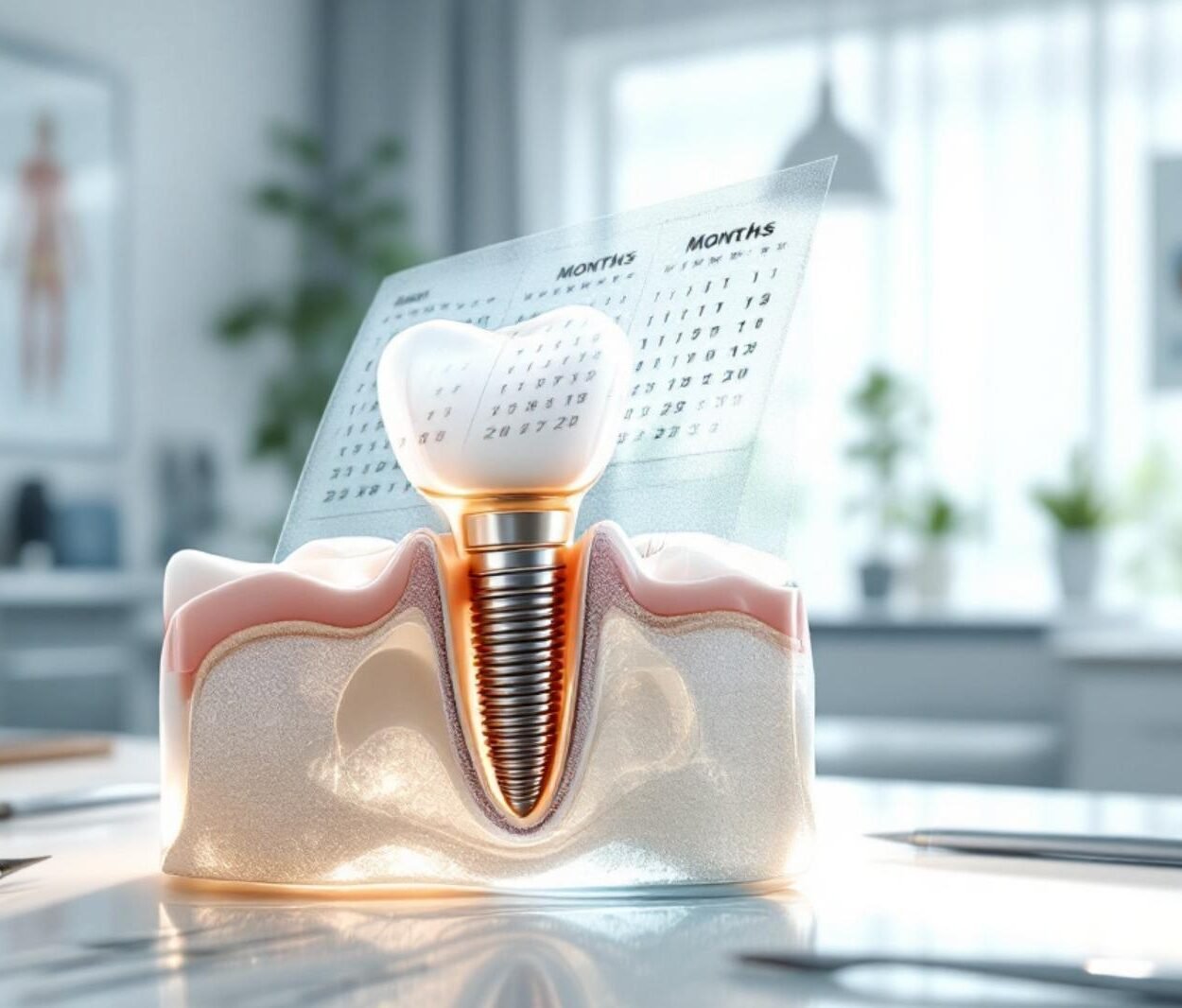Osseointegration is the natural process where your jawbone fuses directly with a dental implant, creating a strong and stable foundation for a new tooth. This crucial healing stage typically takes between three to six months. Understanding this timeline and the factors involved is key to ensuring your dental implant is successful for years to come, giving you a secure and permanent smile.
What Exactly is Osseointegration?
Osseointegration is the remarkable biological process that allows a dental implant to become a permanent part of your jaw. It refers to the direct structural and functional connection that forms between the living bone and the surface of the artificial implant, which is typically made of biocompatible titanium.
This isn’t just a mechanical attachment; it’s a deep fusion at the cellular level. Over time, new bone cells grow on and around the implant’s surface, locking it firmly in place.
This process is the cornerstone of modern dental implantology because it provides incredible stability and strength. A successfully osseointegrated implant can withstand the powerful forces of chewing, just like a natural tooth root. It ensures the replacement tooth is secure, preventing any shifting or looseness.
How Long Does Osseointegration Usually Take?
The general timeline for complete osseointegration is about three to six months. However, this is just an average, and the exact duration can vary significantly from one person to another.
The first few weeks after surgery are critical for achieving initial stability. This is when the implant is held in place mechanically by the surrounding bone. From there, the biological process of bone remodeling and fusion takes over, gradually creating a powerful, long-lasting bond. Your dentist will monitor this progress carefully before placing the final crown.
| Healing Phase | Typical Timeline | What is Happening |
|---|---|---|
| Initial Healing | First 2-4 Weeks | Initial mechanical stability is achieved. The site begins to heal. |
| Active Osseointegration | 1-4 Months | New bone cells actively grow and attach to the implant surface. |
| Full Integration | 3-6 Months | The bond matures, creating a strong, stable fusion between bone and implant. |
Key Factors that Influence Healing Time
Several important factors can either speed up or slow down the osseointegration process. It’s not a one-size-fits-all timeline, and your dental professional will consider these elements when estimating your personal healing period.
Understanding these variables can help you have realistic expectations and take steps to ensure a smooth recovery. Your overall health and daily habits play a surprisingly significant role in the outcome.
Some of the most critical factors include:
- Patient Health: Systemic conditions like uncontrolled diabetes can impair blood flow and slow healing. Smoking is a major risk factor, as it restricts oxygen in the bloodstream and significantly increases the risk of implant failure.
- Bone Quality and Quantity: The density and volume of the jawbone at the implant site are crucial. Areas with dense, healthy bone tend to integrate faster than areas with softer, less dense bone.
- Implant Design: Modern implants with rough, treated surfaces offer more surface area for bone cells to attach to, which can promote faster and stronger integration compared to older, smooth-surfaced designs.
- Surgical Technique: The skill of the surgeon is paramount. Accurate placement with minimal trauma to the surrounding tissue ensures good initial stability, which is essential for the process to begin successfully.
How to Promote a Successful Osseointegration
While you can’t force your body to heal faster, you can create the ideal environment for successful osseointegration. Following your dentist’s instructions diligently is the most important step you can take.
This involves careful post-operative care, especially in the weeks immediately following your surgery. Your actions during this period directly impact the long-term success of the implant.
Meticulous oral hygiene is non-negotiable. Keeping the area clean and free of bacteria helps prevent infections that could jeopardize the entire process. This means regular brushing, gentle flossing around the area as instructed, and using any prescribed antimicrobial mouthwash. Additionally, eating a balanced diet rich in nutrients that support bone health, like calcium and vitamin D, can contribute positively to the healing process.
How Dentists Check if the Implant has Integrated
Your dental professional won’t just guess when the implant is ready. They use specific methods to monitor and assess the progress of osseointegration to ensure the implant is stable enough to support a crown.
These check-ups are a vital part of the implant procedure. They allow your dentist to identify any potential issues early on, such as poor integration or instability, and intervene if necessary.
The most common way to evaluate osseointegration is through imaging. Your dentist will take X-rays or CT scans at follow-up appointments to visually inspect the bone around the implant. These images show how well the bone is growing and fusing with the implant surface. They may also perform a physical stability test to gently check for any movement, confirming that a solid bond has formed before proceeding with the final restoration.
Frequently Asked Questions
What is osseointegration and why is it important for my implant?
Osseointegration is the process where your jawbone grows into and fuses with the dental implant. It’s vital because this fusion provides the strong, stable base needed to support your new tooth, making it feel and function just like a natural one.
What happens if osseointegration fails?
Though rare, failure can occur due to infection, poor bone quality, or other health factors. If an implant fails to integrate, it may become loose or cause discomfort and will likely need to be removed by your dentist.
How can I help my implant integrate successfully?
To promote success, follow all post-operative instructions from your surgeon. This includes maintaining excellent oral hygiene, avoiding smoking, eating a healthy diet, and not putting pressure on the implant during the initial healing period.
Is the osseointegration process painful?
The surgical placement of the implant will involve some post-operative discomfort, which is manageable with medication. The actual process of osseointegration itself is silent and painless as your bone heals and fuses with the implant over several months.









Leave a Comment